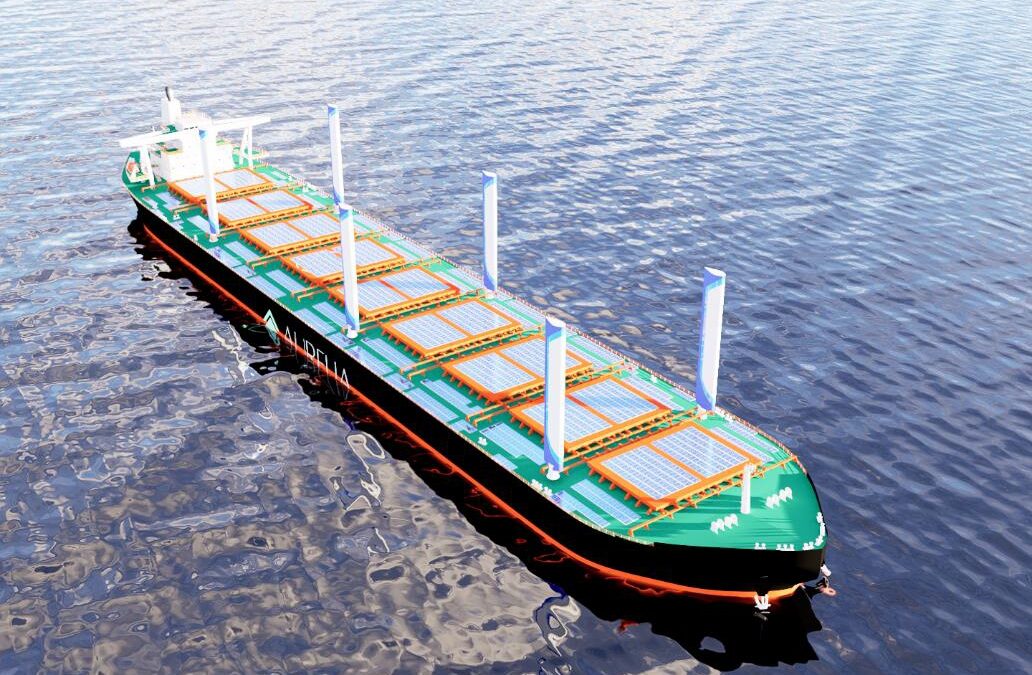A joint venture between ship design company Aurelia, shipping company NEPA and wind propulsion specialists Aloft Systems seeks to demonstrate how to combine innovative solutions and smart decisions for a faster decarbonisation of shipping. They are putting an existing bulk carrier to the test.
The three companies plan to retrofit a 203,000 DWT Newcastlemax bulk carrier curently having Category D for the coming years so that it will comply with the Carbon Intensity Indicator (CII) and rise to category C.
A budget of USD 10 million is available for the project, which will see the vessel fitted with rigid sails, solar panels, batteries, optimised weather-routing and a smart decision support system, developed by Hydrographic and Marine Consultants (HMC), to make a green future closer. Aurelia is involved as the naval architecture designer, while Aloft Systems will bring its expertise in sails and weather-routing.
CII RATING
The CII determines the annual reduction factor needed to ensure continuous improvement of a ship’s operational carbon intensity within a specific rating level. The actual annual operational CII achieved must be documented and verified against the required annual operational CII. This enables the operational carbon intensity rating to be determined.
Based on a ship’s CII, its carbon intensity will be rated A, B, C, D or E (where A is the best). The rating indicates a major superior, minor superior, moderate, minor inferior, or inferior performance level. The performance level will be recorded in a “Statement of Compliance” to be further elaborated in the ship’s Ship Energy Efficiency Management Plan (SEEMP).
A ship rated D for three consecutive years, or E for one year, will have to submit a corrective action plan to show how the required index of C or above will be achieved. Administrations, port authorities and other stakeholders as appropriate, are encouraged to provide incentives to ships rated as A or B.
Two retrofit steps
The challenge for the Newcastlemax bulk carrier is to meet the Energy Efficiency eXisting ship Index (EEXI) and the CII index in terms of reducing CO2 emissions. The vessel used is a 203,000 DWT bulk carrier with a length of 300 metres, a beam of 50 metres and a range of 24,500 nautical miles. Aurelia provided a solution overview to comply with the CII index based on five annual sailings between Brazil and China.
To comply with the CII index, Aurelia proposes to the shipowner two investments steps:
- Investment to be done by 2023: Solar panels, batteries and installation of SafePlan software developed by HMC.
- Investment to be done by 2025: six 30-metre-high rigid sails.
Aurelia has developed a CII calculator used to assess the current status of the vessel, which was used as the starting point. The CII level of the vessel was calculated to be D, which means it is necessary to take action to bring the vessel into compliance.
The main engine power of the bulk carrier is 17 MW, its two generators supply 560 kW each. The total heavy fuel oil consumption of the main engine is 16,223 tonnes per year, and its CO2 emissions per year are 50,518 tonnes. The generators use 1120 tonnes of marine gas oil (MGO) a year, which equals 3592 tonnes of CO2 emissions.
Also read: RINA approves Aurelia’s 100% hydrogen powered RoRo design
Solar panels, batteries and decision support
The first retrofit step will see the vessel fitted with solar panels, batteries and installation of a Management Science application and decision support system, called SafePlan software. The solar panels and batteries are to reduce the hours in service for the auxiliary engines while taking advantage of the free area on deck. In addition, the solar panels will also be used for hotel load during daylight sailing with a surplus of power to recharge the battery bank, which are used for hotel loads during night-time navigation.
The full deck area, including hatch covers, will be fully equipped with solar panels for a peak power of 1MWh. A fully charged battery bank will be reached in about twelve hours. Output of the 660 batteries for 12 hours will be about 550 kW. Total CO2 emission reduction is estimated to be 6.1 per cent, which represents 3305 tonnes of CO2 reduction per year.
After the first major investment in installing the solar panels, the MGO fuel reduction is 97.5 per cent. Fuel costs reduction in total will be 12.5 per cent, which currently represents USD 1,287,900.00 per year. To this value needs to be added the fuel costs saving thanks to SafePlan HMC software, which is between three and five per cent. Therefore, the generators are mainly replaced by batteries, solar panels and SafePlan software for CII index reduction.
Sails from 2025
By the beginning of 2025, a second major investment should be required by installing rigid sails for wind-assisted propulsion and switching from fossil to biofuels for further emission reductions. The Aurelia design reached 1237 kW of energy a day based on the sails being operation 67 per cent of the day.
After the second major investment, CO2 reduction is 10.3 per cent or 5560 tonnes per year. Fuel costs reduction is estimated to be a further 16.3 per cent which nowadays represents USD 1,686,720.00 per year. To these values needs to be added the fuel costs saving thanks to the SafePlan software, of between three and five per cent.
The sails will be installed on the main deck between/aside the hatches to avoid shadows on the solar panels. It is strongly recommended to optimise the route of the vessel, especially for large distances, to take as much wind as possible to support the propulsion of the ship. Trainee courses are provided to the crew and constant updates are going to be available.
Also read: First Oceanbird type wind-powered vessel wins EU funding
A more extensive version of this article will be published in SWZ|Maritime’s February 2023 issue. Not yet a subscriber? Visit our subscription page.








